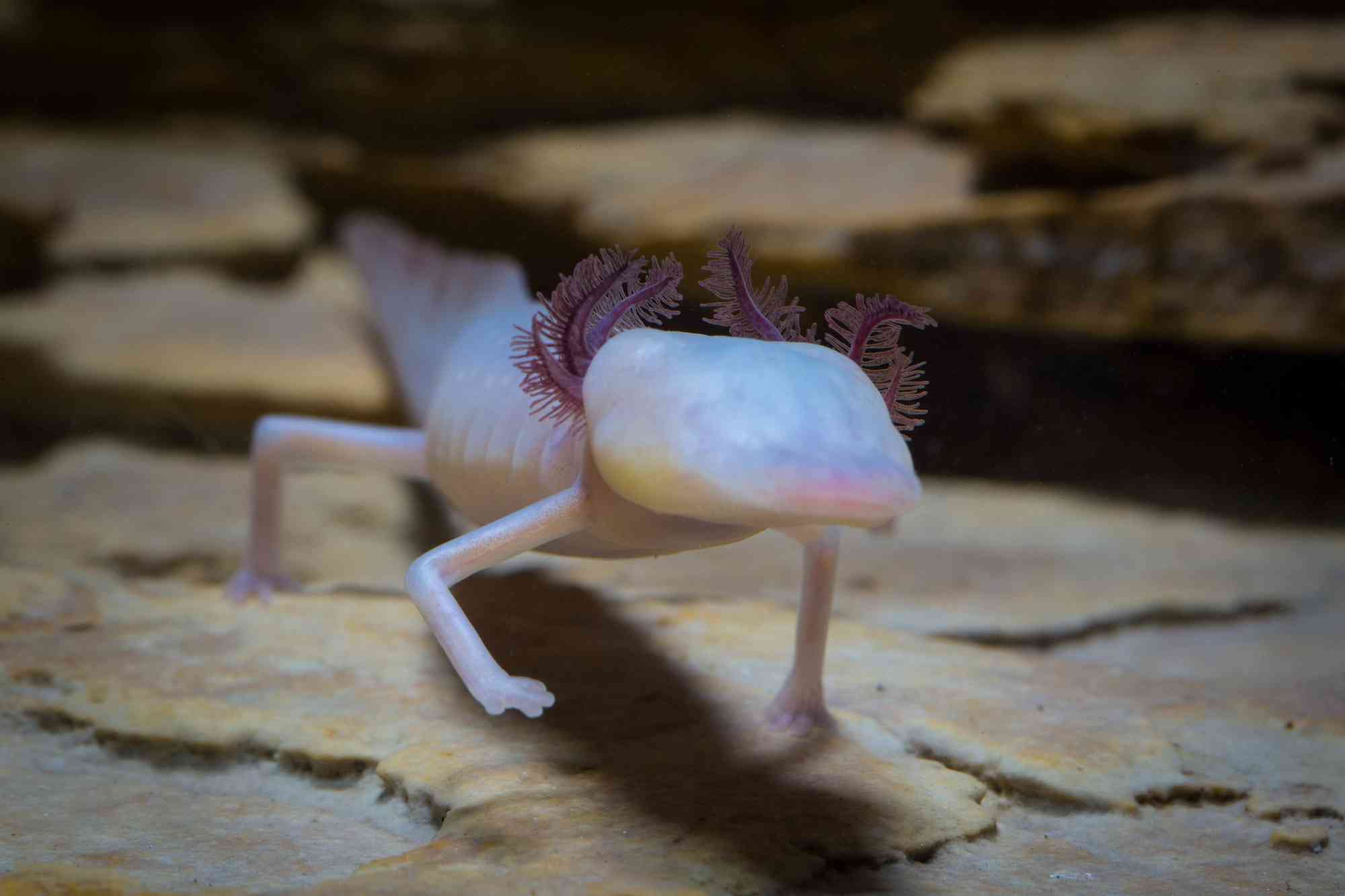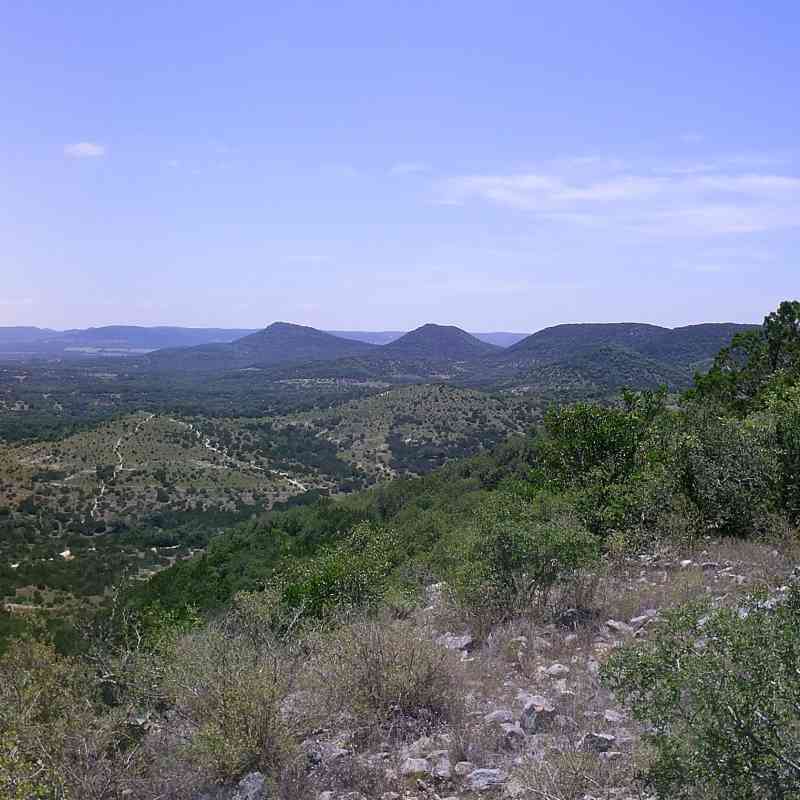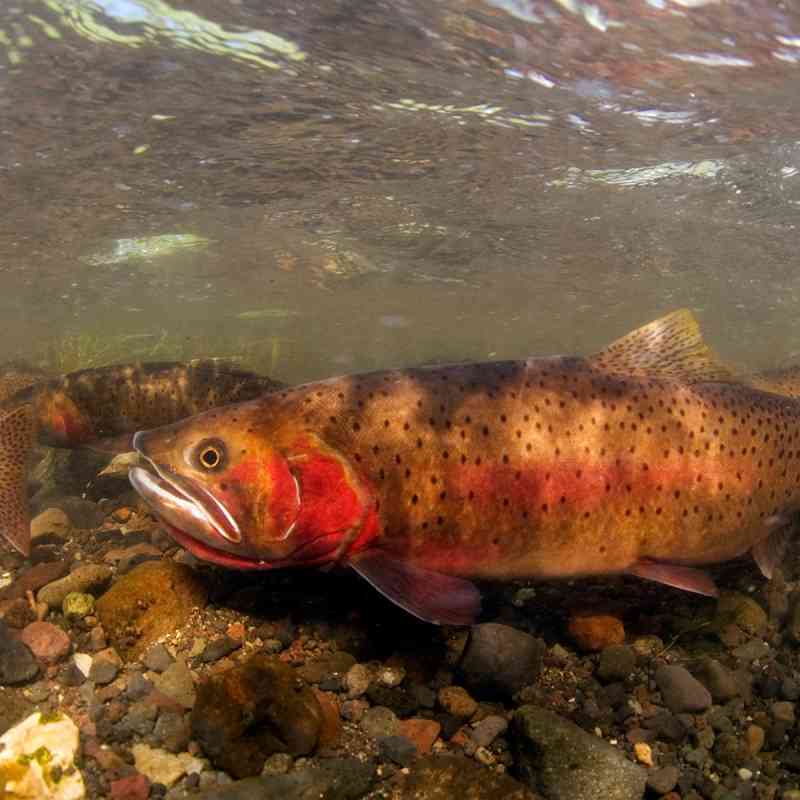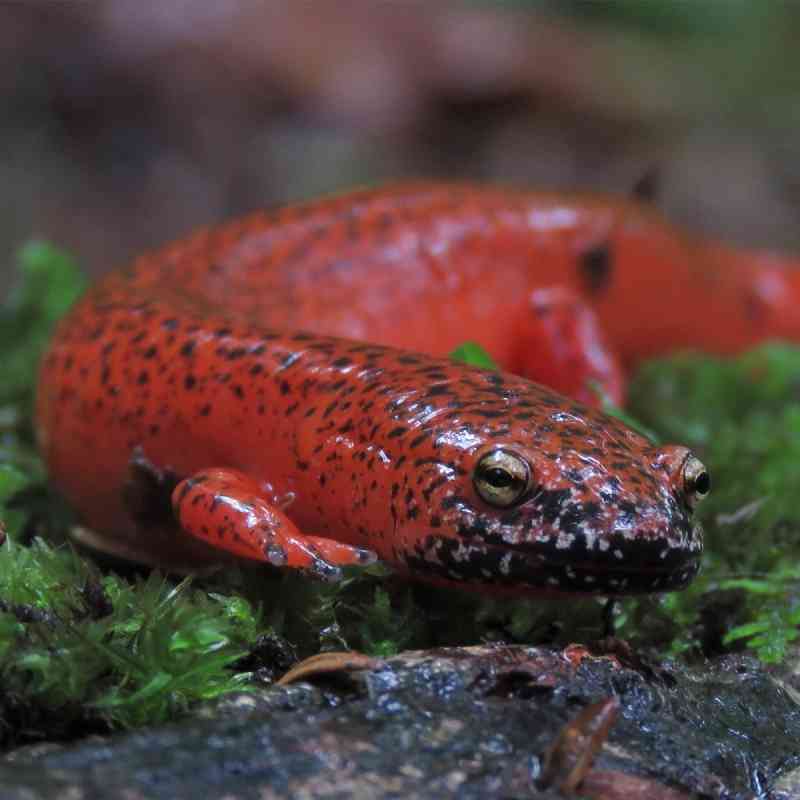Texas Treasures are unique and imperiled aquatic wildlife found in Texas with a restricted and limited habitat. Throughout their range, Texas Treasures prefer clean cool aquatic habitats, from deep aquifers in Central and South Texas to springs and cave systems in the Texas Hill Country. Texas Treasures are an aquatic indicator species that measure the state of local environmental conditions such as water quality. The absorbent skin of Texas Treasures makes them extremely sensitive to changes in the environment and can give scientists valuable insight into how an ecosystem is functioning.
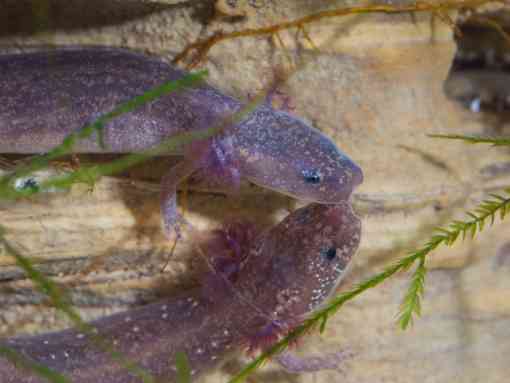
Basic Facts
- The Barton Springs salamander is a slender salamander that is around 2.5 inches long and varies in color from dark gray to yellowish-brown with red external gills.
- The Barton Springs salamander lives its entire life in an aquatic environment and is endemic to the waters of Barton Springs. The salamander is found under rocks or gravel that are several inches to 15 feet deep and can also be found in aquatic plants and algae.
- The Barton Springs salamander relies on a clear and continuous flow of water and lives below and aboveground but is often found under rocks or in gravel. They have also been found in aquatic plants, algae, and caves protecting them from predators.
- The Barton Springs Salamander is carnivorous and feeds on tiny aquatic crustaceans and other small aquatic animals like snails and adult riffle beetles.
Threats to Survival
- The Barton Springs salamander is endemic to a restricted habitat and is vulnerable to groundwater contamination, materials spills, and water withdrawals.
- For most of the 20th century, the Barton Springs Salamander was abundant throughout Barton Springs Municipal Pool. From 1970-1992, their population took a sharp decline due to pool maintenance practices such as high-pressure hoses and chemicals, but since then, the pool has been maintained in ways that do not threaten the species, and the City of Austin has planted vegetation to restore their habitat.
- Urban runoff, pesticide runoff, and soil erosion pose a threat to their survival as they reduce groundwater supply and threaten water quality. Additionally, pesticide runoff has been linked to deformities and deaths in salamanders.
What You Can Do
- Eliminate the use of lawn chemicals and pesticides. However, if you choose to use lawn and agricultural chemicals and pesticides, be sure to limit the use when within the recharge zone of the aquifer to ensure that as little runoff as possible enters the springs.
- Keep trash and pollutants out of natural waters.
- Practice water conservation, especially during periods of drought. You can install fixtures, appliances, and toilets designed to use less water, repair leaky faucets, and turn off the tap when brushing your teeth or doing dishes.
- Swap traditional landscapes for xeriscaping. Xeriscaping is a type of gardening and landscape that reduces or eliminates the need for irrigation. Plus, you save money on your water bill!
- Water your lawns in the evening or morning to reduce evaporation. Create a rainwater collection system for your home to conserve water.
- Do not release aquatic animals and plants into waters to reduce the impact of invasive species.
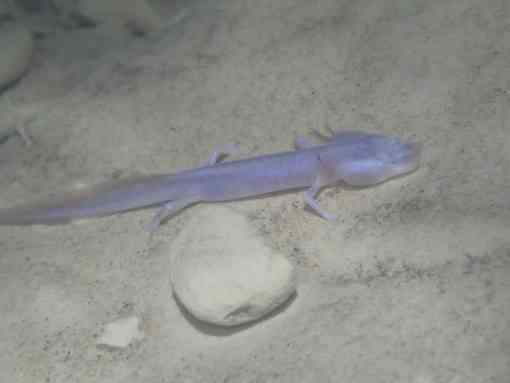
Basic Facts
- The Austin blind salamander is 2.5-3 inches long and gets its name from having no image-forming eyes and only dark spots; this is a result of adapting to life in its primary habitat - the dark, underground waters of the Edwards Aquifer that feed Barton Springs.
- The Austin blind salamander has feathery gills with a relatively short dorsal fin and is pearly white in color.
- The Austin blind salamander is a fully aquatic salamander species that is endemic to the Barton Springs segment of the Edwards Aquifer. They have been found in all four of the springs collectively known as Barton Springs: Parthenia in Barton Springs Pool, Old Mill (Sunken Garden), Eliza and Upper Barton.
- Austin blind salamanders are not typically seen at the surface and are found in subterranean habitats within caves or underground areas. They live in the empty voids between rocks to protect themselves from predators and droughts.
- The Austin blind salamander has been federally listed under the ESA as endangered since 2013.
Threats to Survival
- The primary threats to the Austin blind salamander are the degradation of quality and quantity of water that makes up its habitat as a result of urban expansion.
- The restricted range of the Austin blind salamander makes it vulnerable to groundwater contamination from pollutants, pesticides, and fertilizers.
- Another threat to the Austin blind salamander is low flow conditions in the Edwards Aquifer and at Barton Springs overuse of water. This can be from drought, over pumping and overuse of water.
What You Can Do
- Practice water conservation and prevent pollutants from going into the waterways.
- Properly dispose of hazardous products to keep them from entering the aquifer.
- Be mindful of the Austin blind salamander’s environment because they only have one. Limit disturbances and dispose of trash properly when visiting Barton Springs Municipal Pool.
- Flushing unused prescription medications can pollute the water and lead to hormonal imbalances in aquatic species. Instead, go to Walgreens or other locations that provide free disposal of prescription pills and liquids.
- Raise awareness and become a Defender of Wildlife by spreading the word about the Austin blind salamander.
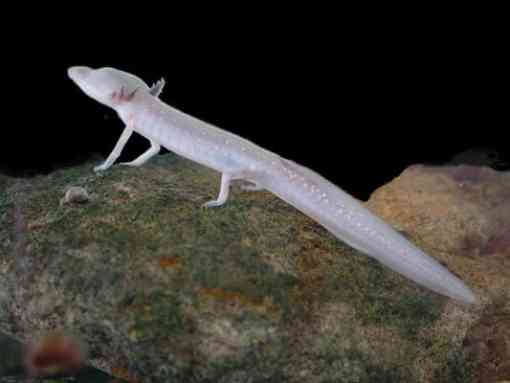
Basic Facts
- The Texas blind salamander is an endangered aquatic species of salamander that is found only within the Edwards Aquifer in Central Texas.
- The Texas blind salamander is cave-dwelling, which has resulted in it being both blind and eyeless. Where most other salamanders have eyes, the Texas blind salamander has two black dots under the skin.
- These lungless salamanders breathe through their gills and are characterized by their lack of eyes, external red gills, slender limbs, a broad head, transparent-pale color, and grow to about 4-5 inches as adults.
- The Texas blind salamander has been federally listed as endangered since 1967.
Threats to Survival
- The Texas blind salamander faces threats such as pollution and overuse of water caused by growing cities.
- The Texas blind salamander is endangered due to its limited range and vulnerability to impacts from increased pumping of the aquifer, extreme drought, and chemical pollution.
What You Can Do
- Practice water conservation and prevent contaminants and pollution from entering the aquifer by properly disposing of hazardous products.
- Flushing unused prescription medications can pollute the water and lead to hormonal imbalances in aquatic species. Instead, go to Walgreens or other locations that provide free disposal of prescription pills and liquids.
- When visiting Comal or San Marcos Springs, it is important to be mindful of the species environment, limit disturbance, and dispose of trash properly.
- Raise awareness and become a Defender of Wildlife by spreading the word about the Texas blind salamander.
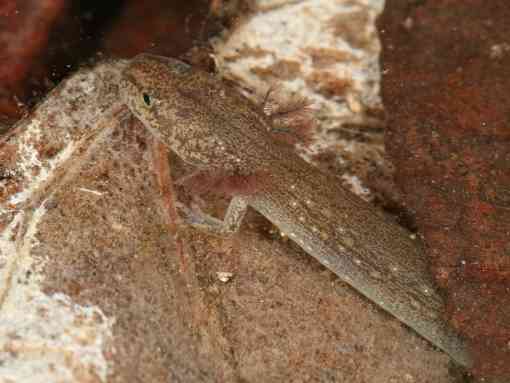
Basic Facts
- The Jollyville Plateau salamander is a threatened aquatic-dwelling salamander found in the Jollyville Plateau and Brushy Creek areas of the Edwards Plateau in Travis and Williams Counties.
- The two-inch-long, neotenic (does not transform into a landform) Jollyville Plateau salamander retains gills for its entire life.
- The salamander spends all its time underwater, inhabiting springs, spring runs, and wet caves fed by the Edwards Aquifer in central Texas.
- The Jollyville Plateau salamander was discovered in 2000 and is federally listed as threatened in 2012.
- Scientists believe the salamander is likely two species, or at least two distinct populations divided by a major highway.
Threats to Survival
- As urban development booms, this salamander's population declines. Development exposes the sensitive amphibian, its eggs, and its invertebrate prey to major water pollution, which is already causing salamander deformities and death.
- Other threats to this species include pollution and changes in spring flow due to natural causes or man-made pollution.
- Due to a limited geographical range and degradation of its habitat, the Jollyville Plateau salamander remains vulnerable.
What You Can Do
- Practice water conservation and prevent contaminants and pollution from entering springs by properly disposing of hazardous products.
- Residents of Travis and Williams counties can help to restore and maintain water quality by carefully disposing of motor vehicle fluids, washing cars at a commercial car wash (where the water is captured & recycled), fertilizing wisely (organically), using compost, and planting native plants that have no need for chemical pesticides & herbicides.
- Raise awareness and become a Defender of Wildlife by spreading the word about the Jollyville Plateau salamander.
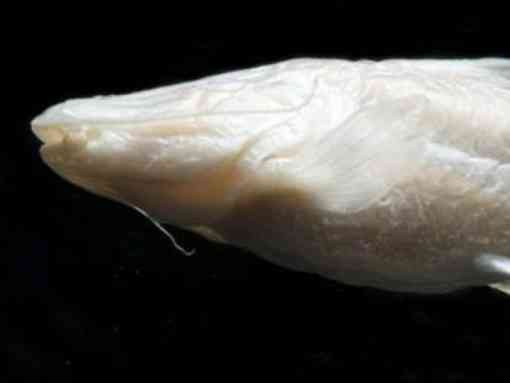
Basic Facts
- The Widemouth blindcat is a rare species of catfish that lives in total darkness, 900 feet below the surface in San Antonio, Texas.
- Appropriately named, this satanic species is eyeless with transparent skin and swims in the groundwater in the Edwards Balcones Fault Zone Aquifer and feeds on invertebrates and is a predator.
- Their transparent skin allows their blood to show through, giving them their pink appearance.
- Once thought to be extinct, little is known about the species because it hasn’t been captured in over 45 years. The only way we even know about this deep aquifer species is because it was captured through agriculture wells and artesian springs that pump groundwater to the surface.
- The Widemouth blindcat has been proposed to be listed under the Endangered Species Act by the U.S. Fish and Wildlife Service.
Threats to Survival
- The major threat to Widemouth blindcats is over-pumping aquifers and discharge from wells causing blindcats to be lost, injured, and killed during the process.
- The Widemouth blindcat occupies a limited range, and populations have likely been severely reduced since the introduction of groundwater wells in the late 19th to early 20th centuries.
- Additionally, the assumed life history traits (such as lower numbers of reproductively active females, reduced numbers of eggs, and slower growth rates) of the species make them more susceptible to long-term impacts in the form of lower numbers of sexually mature fish, reduced reproductive output, and diminished recruitment of younger individuals.
What You Can Do
- Raise awareness and become a Defender of Wildlife by spreading the word about the rare Widemouth blindcat.
- Practice water conservation and prevent contaminants and pollution from entering aquifers by properly disposing of hazardous products.
- Support current blindcat research and conservation programs that are helping the Widemouth blindcat.
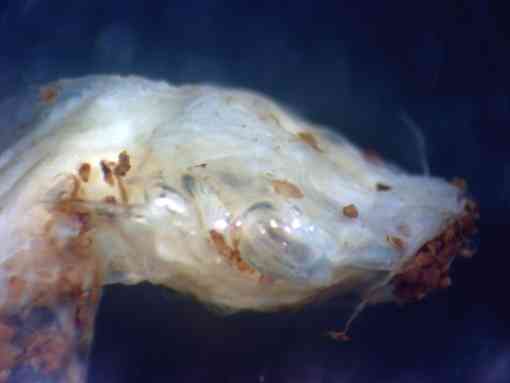
Basic Facts
- The Toothless blindcat is one of two highly cave-adapted eyeless species of catfish endemic to the Edwards Aquifer. This rare species exists in total darkness, 900 feet below San Antonio, Texas.
- The Toothless blindcat is around 4 inches long and lacks eyes and jaw teeth with pinkish-white depigmented skin.
- Its toothless mouth is adapted for scraping bacterial mats from cavern walls. The blindcat scavenges food sources both from invertebrates and fungus with its sucker-like, whiskered mouth.
- The Toothless blindcat dwells in a humanly inaccessible habitat and the only way we even know about this deep aquifer species is because it is captured through wells and artesian springs that pump groundwater to the surface.
Threats to Survival
- The major threat to Toothless blindcats is over-pumping aquifers and discharge from wells causing blindcats to be lost, injured, and killed during the process.
- The Toothless blindcat occupies a limited range, and populations have likely been severely reduced since the introduction of groundwater wells in the late 19th to early 20th centuries.
- Additionally, the assumed life history traits (such as lower numbers of reproductively active females, reduced numbers of eggs, and slower growth rates) of the species make them more susceptible to long-term impacts in the form of lower numbers of sexually mature fish, reduced reproductive output, and diminished recruitment of younger individuals.
What You Can Do
- Raise awareness and become a Defender of Wildlife by spreading the word about the rare Toothless blindcat.
- Practice water conservation and prevent contaminants and pollution from entering aquifers by properly disposing of hazardous products.
- Support current blindcat research and conservation programs that are helping the Toothless blindcat.
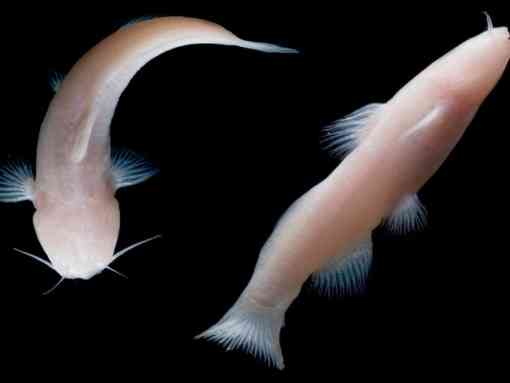
Basic Facts
- The Mexican blindcat is a species of rare catfish that is endemic to the Edwards-Trinity Aquifer and lives 2,000 feet underground, in Texas and Coahuila, Mexico.
- As their name implies, they are eyeless and can grow to be 5 inches long with pink in color due to their translucent skin that allows blood vessels to show through.
- Mexican blindcats have a snout that overhangs their mouth with a sharp sense of smell making them predators to many macroinvertebrates.
- Their lateral lines help them detect motion in the water, and they’ll swallow any small prey they come across, though they can survive long periods without eating.
- Although most people do not see them Mexican blindcats are important. Their health and well-being reflect the health of the groundwater, which we are completely dependent on for drinking water.
- Once believed only to be living in Mexico, the Mexican blindcat was discovered in Texas in 2015. The blindcats presence in Texas shows that the watershed is connected across the border and reflects the connection of human and natural communities between the two countries.
Threats to Survival
- The biggest threats to the Mexican blindcats’ survival are overuse of groundwater and pollution from pesticides and chemicals.
- The overuse of groundwater in aquifer systems like the one that supports this rare fish is also the lifeblood of human populations. These threats are a result of urban development and expansion.
- The rock system in the Edwards-Trinity aquifer is very porous and allows pollutants to come through easily. This adsorbate rock is vulnerable to contamination from agriculture, development, and fossil fuel extraction, which all harm the species and its habitat.
What You Can Do
- Raise awareness and become a Defender of Wildlife by spreading the word about the rare Mexican blindcat.
- Practice water conservation and prevent contaminants and pollution from entering aquifers by properly disposing of hazardous products.
- Support conservation efforts that support the Mexican blindcat like visiting the San Antonio Zoo which has a Department of Conservation and Research housing a pair of Mexican blindcats.
Wildlife and Wild Places

